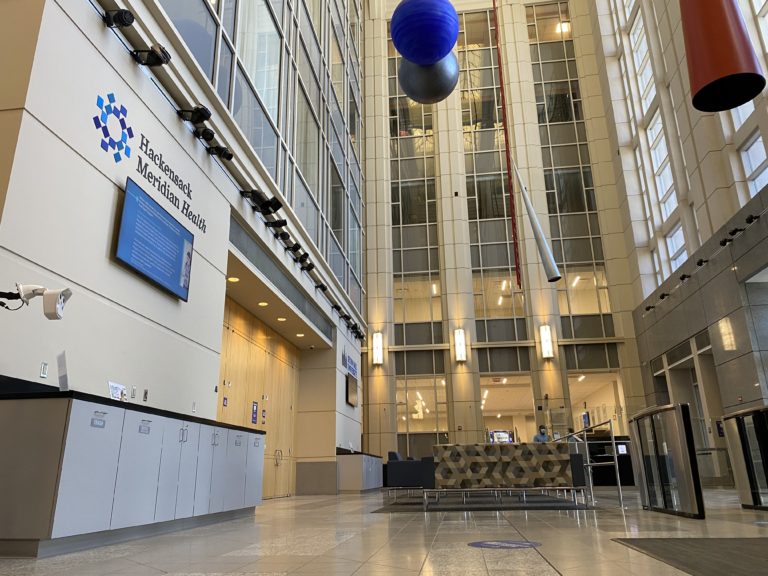SOM Students’ COVID-19 Real-Time Research Effort Makes Major Journal
March 30, 2021

Hackensack Meridian School of Medicine students, working hard on clinical research at the height of the first wave of the COVID-19 pandemic, had a major positive impact on the clinical front lines.
The eight-student team of researchers found and reported on the breaking medical news from pre-print publications back to the Hackensack Meridian Health clinical teams every day for six weeks last year, helping teams stay on top of the latest discoveries in the then-new pandemic.
The team’s work was recently recounted in the major peer-reviewed journal Academic Medicine.
“These students who are just starting their medical careers have already made a major contribution toward medicine,” said Bonita Stanton, M.D., the founding dean of the medical school, and one of the authors. “Their skills were available, and helped their future colleagues on the front lines at a time of critical need.”
“The research at that time in the pandemic exploded at an exponential rate,” said Jeffrey Boscamp, M.D., vice dean of the medical school and a professor of pediatrics, and also a veteran infectious disease doctor, who is also an author of the paper. “These students were eager and capable to help out, even when they couldn’t be directly helping through their clerkships.”
The venture was an initiative co-led by Christopher Duffy, MLIS, AHIP, the associate dean of the Health Sciences Library at the Interprofessional Health Sciences Campus of which the medical school is part, and Vice Dean Boscamp.
The idea for the initiative came from the HMH pandemic leadership team, Drs. Jerry Zuckerman, M.D., vice president of infection prevention and control at Hackensack Meridian Health; Daniel Varga, M.D., chief physician executive; and Carol Barsky, M.D., MBA, executive vice president and chief quality officer of Hackensack Meridian Health who reached out to Stanton. The hope was the second-year medical students might have the time to pull together the daily explosion of new news on the pandemic and present it to them in a distilled fashion.
The students had the time available, since their second-year clerkships were interrupted, in the wake of the Association of American Medical Colleges (AAMC) recommendation in March 2020 that medical students nationwide end all patient contact.
The students who were asked to take part were: Austin Krebs, Katie Veltri, Daniel Menza, Helen Pozdniakova, Kevin Brandecker, Eric Stanton, Candace Pallitto, and Catherine Hahn.
The Interprofessional Health Sciences campus librarians, including Duffy, helped to guide them through the thicket of data.
The elective course included searches of PubMed, as well as the databases of BioRxiv and MedRxiv, which are pre-print servers hosted by Cold Spring Harbor Laboratory, the BMJ, and Yale, looking for the up-to-the-minute latest findings from around the world.
“The students really rose to the challenge,” said Duffy.
The students found the growing information, distilled it into summaries, and relayed that fast-flowing data into the clinical settings of the health network.
Over the course of six weeks, the team produced 70 reports, which were distributed throughout the Hackensack Meridian Health network. They were also posted on the American Academy of Ophthalmology website and were published in their entirety on the faculty hub of the Elsevier publishing group.
Within hours of the initiative’s start on March 23, 2020, the research made its first clinical impact.
The critical question, needed by mid-afternoon the same day, was to determine the best evidence indicating when it was safe to send patients back to nursing homes after COVID-19 infection.
Austin Krebs, the student assigned the question, cracked the (virtual) books. Within hours, Krebs had pulled from nearly a dozen sources. The latest CDC guidelines of isolation and fever monitoring, were complemented by findings that were just days old: the latest findings in how long patients stay positive on PCR test for the virus (from JAMA); the behavior of SARS-CoV2, in terms of viral shedding (the New England Journal of Medicine); the possibility of fecal-to-oral viral transmission (from the Lancet Gastroenterology and Hepatology); and how long mild cases of COVID-19 may still remain infectious (The Lancet Infectious Disease).
Together, they came up with a conservative recommendation to limit potential exposures. And those recommendations reduced risk for everyone. Krebs said he’s embraced the new role, even though it wasn’t what he was expecting for his second year of medical school.
“Searching for an answer regarding nursing-home discharges on Monday only emphasized how valuable our contributions can be,” Krebs added, at the time. “The deadline made everything much more real, and I did my best to comb through the literature (with help, of course) to suitably answer a deceptively simple question in a timely manner.”
To view some of the students’ latest research summaries, visit the elective course page.
